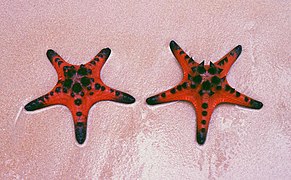Protoreaster nodosus
| Horned sea star | |
|---|---|

| |
| Scientific classification | |
| Domain: | Eukaryota |
| Kingdom: | Animalia |
| Phylum: | Echinodermata |
| Class: | Asteroidea |
| Order: | Valvatida |
| Family: | Oreasteridae |
| Genus: | Protoreaster |
| Species: | P. nodosus
|
| Binomial name | |
| Protoreaster nodosus | |
Protoreaster nodosus, commonly known as the horned sea star or chocolate chip sea star,
Description



P. nodosus possess rows of spines or "horns"; black conical points arranged in a single row, radially on the dorsal side, which may erode and become blunt. These dark protrusions are used to scare away possible predators, by looking frightening or dangerous. On the ventral side, tube feet, purple in color (or pale, transparent pink), are arranged in rows on each arm. Most horned sea stars found are a roughly rigid five-pointed star-shape with tapering arms to the end, although there are anomalies like four or six-armed specimens; they may grow up to 30 cm (12 in) in diameter.[2] The sea stars are usually colored in shades of red or brown, but can be light tan, the color of cookie dough. This appearance, combined with the small horns on its dorsal side, give the sea star a look similar to that of a bumpy cookie.
-
Oral face
Habitat and behavior
Horned sea stars prefer sheltered,
Horned sea stars seem to be opportunistic carnivores; adults are known to prey on most sessile life forms including hard
As with other tropical
Overharvesting
In many tropical Asian and Pacific countries, where horned sea stars are collected for
References
- ^ "Shedd Aquarium". Archived from the original on 2007-10-11. Retrieved 2007-11-10.
- hdl:2066/72067.
- ^ Gremli MS, Newman HE, Insight Guides Underwater: Marine Life In the South China Sea, page 159. APA Publications GmbH & Co. Verlag KG., 1993
Bibliography
- Ducarme, Frédéric (2022). "How to assess the absence of a species? A revision of the geographical range of the horned sea star, Protoreaster nodosus (Echinodermata; Asteroidea)". Frontiers of Biogeography. 14 (3). .
External links
- Wild Fact Sheet's fact sheet for Protoreaster nodosus
- Photos of Protoreaster nodosus on Sealife Collection



